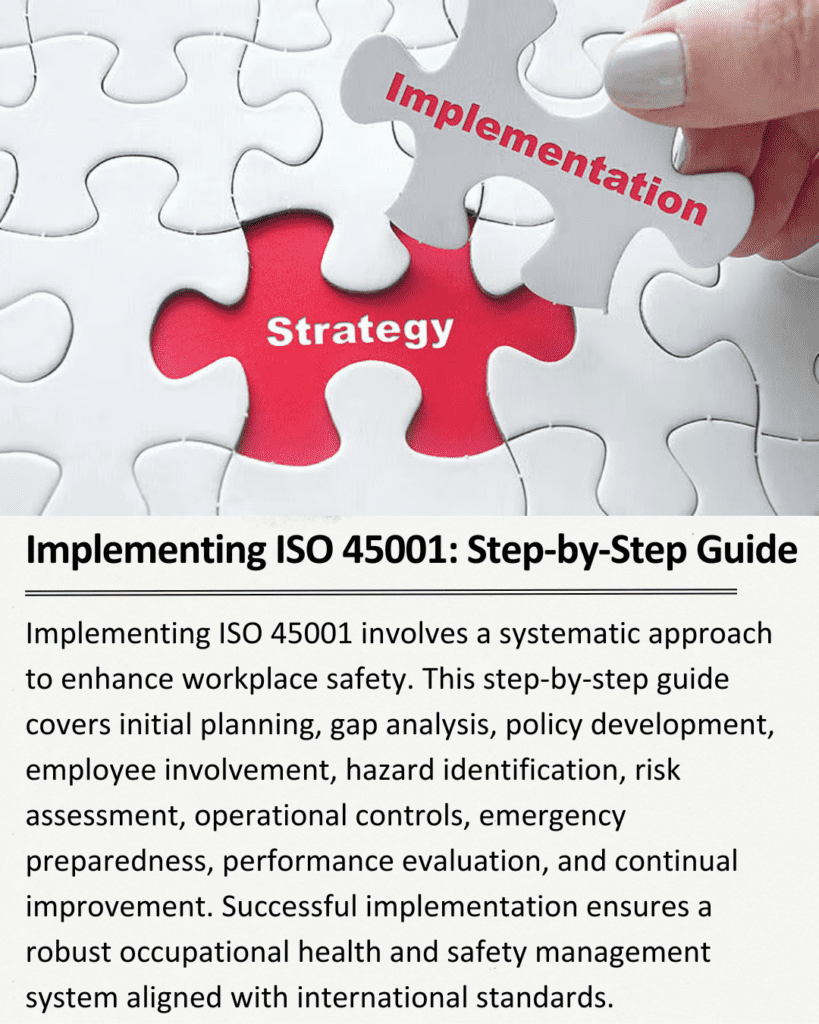ISO 45001:2018 is a comprehensive standard for occupational health and safety (OH&S) management systems. Implementing it can significantly enhance workplace safety and health, but the process can be complex. This step-by-step guide provides a detailed walkthrough from planning to certification.
Step 1: Understand the Requirements
Before beginning the implementation process, it’s crucial to thoroughly understand the requirements of ISO 45001:2018. This involves:
- Familiarizing with the Standard: Read and comprehend the clauses and requirements of ISO 45001. Training sessions or workshops can be beneficial.
- Understanding the Organizational Context: Analyze internal and external factors that can affect the OH&S management system. Identify stakeholders and understand their needs and expectations.
Step 2: Conduct a Gap Analysis
A gap analysis helps identify the differences between your current OH&S practices and the requirements of ISO 45001:
- Review Existing Systems: Evaluate your current OH&S policies, procedures, and practices.
- Identify Gaps: Determine where your current system does not meet ISO 45001 requirements. This could include documentation, risk management practices, and employee training programs.
Step 3: Secure Top Management Commitment
Top management’s commitment is critical for successful implementation:
- Engage Leadership: Ensure top management understands the benefits and requirements of ISO 45001. Highlight the importance of their role in promoting a safety culture.
- Establish OH&S Policy: Develop or revise the OH&S policy to align with ISO 45001 requirements, ensuring it reflects the organization’s commitment to health and safety.
Step 4: Establish a Project Plan
A detailed project plan will guide the implementation process:
- Set Objectives and Targets: Define clear, measurable OH&S objectives aligned with the organization’s strategic goals.
- Allocate Resources: Identify and allocate necessary resources, including personnel, budget, and time.
- Develop a Timeline: Create a realistic timeline with milestones for each phase of the implementation.
Step 5: Build a Competent Team
Form a team responsible for implementing ISO 45001:
- Assign Roles and Responsibilities: Clearly define roles and responsibilities for team members.
- Provide Training: Ensure the team is trained in ISO 45001 requirements and implementation processes.
Step 6: Develop Documentation
Documentation is a critical component of ISO 45001 implementation:
- Create or Update Documents: Develop the necessary documents, including the OH&S policy, procedures, and work instructions. Ensure they comply with ISO 45001 requirements.
- Control Documents: Implement a document control process to ensure documents are reviewed, approved, and updated as needed.
Step 7: Implement the OH&S Management System
With documentation in place, begin implementing the OH&S management system:
- Communicate the System: Ensure all employees are aware of the new OH&S management system, their roles, and how it affects them.
- Conduct Risk Assessments: Identify hazards, assess risks, and implement controls to mitigate those risks.
- Operational Controls: Establish and maintain operational controls to manage risks, including emergency preparedness and response procedures.
Step 8: Foster Worker Participation
Worker participation is crucial for a successful OH&S management system:
- Consult Workers: Engage workers in the development and implementation of OH&S policies and procedures.
- Promote Participation: Encourage workers to report hazards, participate in risk assessments, and contribute to continuous improvement efforts.
Step 9: Monitor and Measure Performance
Monitoring and measuring OH&S performance helps ensure the system is effective:
- Establish Metrics: Define key performance indicators (KPIs) to measure OH&S performance.
- Conduct Regular Inspections: Perform regular inspections and audits to ensure compliance with the OH&S management system.
Step 10: Conduct Internal Audits
Internal audits are a critical component of the ISO 45001 implementation process:
- Plan Audits: Schedule and plan internal audits at regular intervals.
- Audit Process: Conduct audits to evaluate the effectiveness of the OH&S management system, identify nonconformities, and implement corrective actions.
Step 11: Management Review
Top management should regularly review the OH&S management system to ensure its continuing suitability, adequacy, and effectiveness:
- Review Performance Data: Analyze data from monitoring, measurement, and audits.
- Assess Opportunities for Improvement: Identify opportunities for improving the OH&S management system and establish action plans.
Step 12: Continuous Improvement
Continuous improvement is a fundamental principle of ISO 45001:
- Address Nonconformities: Identify and address nonconformities promptly and implement corrective actions to prevent recurrence.
- Enhance the System: Regularly update the OH&S management system based on audit findings, incident investigations, and feedback from workers.
Step 13: Prepare for Certification
Once the OH&S management system is fully implemented, prepare for certification:
- Select a Certification Body: Choose a reputable certification body accredited to audit and certify ISO 45001.
- Conduct a Pre-Audit: Some organizations opt for a pre-audit or gap assessment by the certification body to identify any remaining issues.
- Schedule the Certification Audit: Arrange for the certification audit, where auditors will assess compliance with ISO 45001 requirements.
Step 14: Certification Audit
The certification audit is the final step in achieving ISO 45001 certification:
- Stage 1 Audit: The auditors will review your documentation and ensure the OH&S management system is ready for a full audit.
- Stage 2 Audit: The auditors will conduct an on-site audit to assess the implementation and effectiveness of the OH&S management system.
- Certification Decision: If the audit is successful, the certification body will issue an ISO 45001 certificate.
Step 15: Maintain Certification
Maintaining ISO 45001 certification requires ongoing commitment:
- Surveillance Audits: Certification bodies typically conduct annual surveillance audits to ensure continued compliance.
- Continual Improvement: Regularly review and improve the OH&S management system to adapt to changes and improve performance.
Conclusion
Implementing ISO 45001:2018 involves a structured approach that includes understanding the standard, conducting a gap analysis, securing top management commitment, developing documentation, and fostering worker participation. By following this step-by-step guide, organizations can create a safer workplace, enhance compliance with legal requirements, and achieve ISO 45001 certification. Continuous improvement and regular monitoring are essential to maintaining the effectiveness and benefits of the OH&S management system.
